-
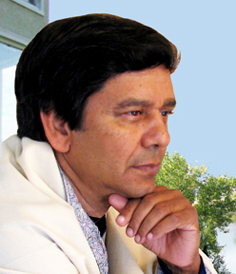
Manick Sorcar
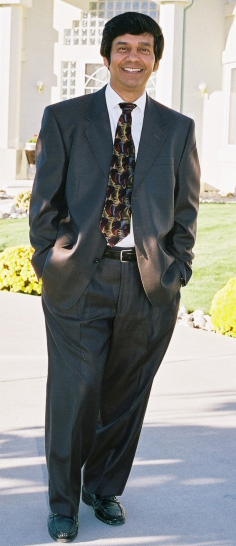
|
Manick Sorcar (formal name Prafulla C. Sorcar), an electrical engineer from
Bengal, India, came to the U.S. in late 1969, received full tuition
scholarship and earned a master’s degree in electrical engineering at the University
of Washington, Seattle. Earlier, in 1968, he received his bachelor's
degree (First Class) in EE from BHU (now IIT-BHU, Indian Institute of Technology-Benaras Hindu University), Varanasi, India. A resident
of Colorado, he was the CEO/President
of Sorcar Engineering,
Inc., the roots of which was Howard W. Butterweck and
Company, where Sorcar was first employed in early 1972. In two years he
earned the position of the vice president, when the company re-incorporated in
1974, taking him as one of the principals and changing the company's
name to "Butterweck-Sorcar Engineering, Inc." This was
the same year when Sorcar married his wife, Shikha. Twenty six years later, in 2000, the company's name was changed
to "Sorcar Engineering, Inc." of which he became the CEO/President.
Sorcar is the author of several texts on lighting design which
are published by renowned publishers (Rapid
Lighting Design & Cost Estimating, McGraw-Hill,
1979, was selected as a 'Book of the Month' by the Architects'
Book Club; Energy
Saving Lighting Systems, Van Nostrand Reinhold, 1983,
a practical application oriented design/reference book; and Architectural
Lighting for Commercial Interiors, John Wiley &
Sons, 1987, is a popular design book which takes the impact of
psychology, physiology, vision, and aesthetics in lighting design).
The last two books have been in use as texts for Architectural
and Illuminating Engineering at several universities for undergraduate and graduate courses
including the University of Colorado, Boulder, PennState
University, Pennsylvania, and Jadavpur University, Kolkata, India. Over the years 1972 to 2012, his
innovative lighting design has reached several countries through
multi-billion dollar projects such as the Denver
International Airport, Colorado Convention Center, Denver Justice Center, etc. in the USA; Palace for Prince H.H. Faisal Bin Sultan
in Saudi Arabia; Shinurayasu and Musashi-Koshugi sport centers in Japan, to name a few. After 40 years of phenomenal success, Sorcar retired from engineering in 2012.
Sorcar's simultaneous love for art and science is something he inherited from
his legendary father, Late P. C. Sorcar, the world-renowned magician.
As a youngster, apart from being a stage assistant, he helped in painting
the backdrops and lighting design for the various massive stage sets of magic items,
which led him to become an electrical engineer and artist. In
the U.S., his art in many forms flourished simultaneously with
engineering.
"From the outset his endeavors were underlined by one goal - to bring the East to the West through his innovative creations. The underlying thread that weaved together all of Sorcar's work was art. Combining his father's charisma and showmanship with his own artistic insight, Sorcar created a brand of magic which earned him a place in the hearts of thousands all over the world and put him in a niche of his own" (Reprinted from the flap of the book 'World of Manick Sorcar Where Art Becomes Magic', by Roma Sur, Foreword by Patrick Murphy, Executive Director, International Laser Display Association).
This website is dedicated only to the art world of Manick Sorcar.
Over the last few decades he produced a wide variety of unique
arts, which has had a strong appeal to people of all ages. |
| His first art exhibition was held in Seattle, Washington, while
a student at the university, where all of his works reflected
the suffering of the fleeing refugees who poured into India during the war between India and Pakistan. In his
later exhibitions he represented rural India and Indian art painted
with water and acrylic media. He has always been fond of experimenting
and creating novel art work by using unique, unusual material:
portraits on peanuts, grains of rice, portraits
with fireplace charcoal, life size sculptures curved out of styrofoam,
sculptures made out of chicken wires and screen, spice-painting,
tile-collage, three dimensional
illuminated art work with fiber optics, etc. In 1996, a gallery of portraits of famous people
collaged with relevant newspaper pieces was displayed at his art exhibition
"IMAGES OF INDIA: Animation/ Transformation", at the
prestigious Foothills Art Center, Golden, Colorado. "Artist displays wizardry at Foothills" said The
Transcript of Golden, Colorado, "Manick
Sorcar, a lighting engineer and artist from Golden, specializes
in feats that will astound....Taking on sleight of hand few would
attempt the artist has created portraits of Asian and American
newsmakers, using as his medium - newspapers!". |
| Sorcar's love of art is seen in everything
he touched. His current 6,000 sq. ft. residence with a flavor of Moghul Architecture was fully
designed by him and resembles what he calls “mini India”.
It is a way for him to be surrounded by his culture while living
in the States. Although it is just the place he retires to when
he is through with the day, it is acknowledged by the Asian Art Association
of the Denver Art Museum as a true Asian experience. Many patrons
from the Art Museum toured Sorcar’s home to
experience the Asian culture seen within the architecture of the
house and the wall paintings and other artwork created by him. His
home was featured in the weekend edition of the Rocky Mountain News
of Denver, Colorado and defined as a “Shrine
to Indian Culture”. |
 |
The Sorcar Family |
|
|
Sorcar's most notable art
work came in the last three decades as a series of one-man-animation for children: "East-meets-West" (1986), "East-meets-West,
II" (1987), "Two Songs from the East" (1987), "Deepa
and Rupa: A Fairy Tale From India" (1990), "The Sage
& The Mouse" and "Sniff" (1993), "The
Woodcutter's Daughter" (1997), and “The
Rule of Twenty-One”(2003), which are not only entertaining,
but also educational for their cross-cultural values and innovative
arts. In many of these films he uniquely mixed his hand-drawn
art with computer-generated art and animation, and several with
his animation mixed with live action - along with his original
music, to represent the culture of his motherland in a most effective
manner. The products were instantly acclaimed in the USA as a
"bridge between East and West", got sensational response
from the schools, rave reviews from the press, and a host of international
awards. He has been a guest lecturer
at many schools
and universities around the
country.
|
Originally Sorcar did not plan to create the
bridge on an international level, he just wanted to bridge the gap
at home so that his two U.S. born daughters (then 8 and 5, 1985)
could share their heritage with India. So he wrote and composed
several songs in his native Bengali and had the daughters sing them,
which led to a CBS manufactured record and other cassettes which
became popular in the U.S. as well as in India. His daughters received
the Gold Medal at the Kiwani's "Stars of Tomorrow" contest.
One success led to another. In 1986, he started mixing painting
with music which led to "Two Children's Songs From the East",
"East-meets-West", and "East-meets-West, II".
In each of these programs his daughters danced in front of his artwork
and animation, which were appreciated and immediately telecast by
American CableVision, Colorado, and Doordarshan, India. After this,
the bridge of culture widened into an international level - he dreamed
of making "Deepa
& Rupa: A Fairy Tale From India" a half-hour
animation mixed with live action for children of all ages - which
required substantial financing, thousands of art work, and significant
amount of time.
Unable to find any external funding, Sorcar financed the art film himself. In order to have the low-budget, high-quality product,
he used family members and friends to act various roles
and drew the entire art and animation by himself. |
|
Shikha (left), Payal
(middle), Piya (right) |
|
|
Each and every one of the hundreds of background
scenes were painstakingly hand painted on paper and then frame-captured
by a video camera. The moving animations were painted and developed
directly on his personal computer - all in his studio in the basement.
For three long years (1988-90) he religiously devoted his nights,
weekends and all the time he could spare from his electrical engineering
business to translate his dream into reality.
The hard work paid off. Since its premiere on the PBS Channel
(KRMA-TV, Denver) on September 13, 1990, "Deepa & Rupa"
was telecast in many parts of the world and received a host of
awards including
The Gold Plaque at the Chicago International Film Festival, The
Golden Eagle by the Council on International Non-Theatrical Events
(CINE), Washington, D.C., the Silver and Bronze Medals at the
New York International Film and TV Festival, The Cindy Award,
Los Angeles, and nominations in three categories for The Heartland
Regional Emmy Awards, and a bag full of rave reviews. "Deepa
& Rupa humanizes the machine,” said The Denver Post.
"Comparing Sorcar's results with tape and computer to those
more traditional animations seen on Saturday mornings, he (Manick)
just about could be Hanna-Barbera" said the Daily Camera,
and "A fairy tale ending for the Golden producer .... in
a head-to-head competition, it topped the Children's Workshop's
'The Sesame Street' and Hanna-Barbera's 'The Greatest Adventure' said the Rocky Mountain News regarding the awards it received
at the Chicago and New York International Film Festivals.
The productions with Indian stories and universal appeal did not
go unnoticed by schools, which found his videos to be "An invaluable
material. Not only was it an important fairy tale for young children,
but also had educational values for high school students studying
the many uses of computers" said the Aurora Public Schools
of Colorado. Manick started receiving a surge of requests from
schools to make presentations of his art-videos and discuss the
state-of-the-art technology on computer graphics and animation
with the students.
All of his videos in general take the young audience to the world
of children in India and introduce them to the culture, folklore,
and values. "They are entertaining and educational,"
the academicians from various school organizations paid glowing
tribute to Manick's accomplishments saying about the films
"they make a rich addition to a school district's multicultural
resource library," "an inspiration to our students,"
and "the storyline is timeless, teaching values which span
generations."
|
The chain of success continued in his
following productions as well. "The
Sage & The Mouse" and "Sniff" (1993) which were 100% animation, took two years to make. The twin
were premiered on the PBS television stations of Rocky Mountain
area on July 1 and re-telecast on July 4, 1993, the Independence
Day of the USA. They received sensational response, again, from
the viewers and rave reviews from the press. "Animator preserves
cultural legends - reaches children of all ages through work ...
he is nothing but success. In the last decade Manick has made major
contributions to children's arts and cultural education through
a series of self-developed animated programs", said "The
Denver Post." "The Golden Transcript" wrote, "His
father, P.C.
Sorcar, Sr. was a legendary Indian magician, much loved
by his fellow countrymen. Now Manick carries on the creation of
Magic with a hi-tech edge." Both animations received
a host of international awards.
"The Sage & The Mouse," which is based on a fable from the Panchatantra (the classic book of children's stories of India), received the Gold Medal for its music and the Silver Medal for its animation at the New York International Film Festival, and the Bronze Plaque at the Columbus International Film Festival. |
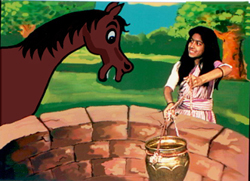
A Scene from Deepa & Rupa

|
A Scene from The Sage
and the Mouse |
|
| "Sniff,"
which is based on Sukumar Ray's famous nonsense poem, received the
Golden Eagle awarded by the Council on International Non-theatrical
Events (C.I.N.E.), Washington, D.C. "Sniff brings to life the
unforgettable characters of Sukumar Ray's poem," said The Statesman,
Calcutta, India, about Manick's animation during its premiere at
Doordarshan (Indian national TV), Calcutta. Its telecast in the
State of Bengal had a very special significance to all Bengalis
as this happened to be the very First animation produced in their
native language, and also the very First animation from Sukumar
ray's famous book Aabol Taabol. |
|
The Woodcutter's Daughter |
Since 1990, Sorcar's animation films have been telecast by the Rocky Mountain PBS Stations of Colorado, USA, for over two dozen years in a row, celebrating its Silver Jubilee (25 years) telecast on January 1, 2014. As a year-end special two hour show for children, they are presented either on the Christmas Eve or the New Year's Day, as the "Animation from India, by Manick Sorcar". |
Based on another story from the Panchatantra,
"The Woodcutter's
Daughter” was released on September 7, 1997, Sunday,
9 am, on KRMA-TV (PBS) channel six in Denver and its affiliated
PBS stations around the State of Colorado. Like Deepa & Rupa
this, too, was mixed with live action (Sorcar's younger daughter
Payal was in the key role) and got rave reviews. At the New York
Festivals it was a FINALIST in the Children's Program category.
“Rule of Twenty-One,”
his latest animation based on another nonsense poem by Sukumar
Ray, received the Bronze Plaque at the 51st Columbus International
Film Festival, Ohio, USA. It was premiered at Uttam Mancha theatre
at Calcutta, India, on December 21, 2002 and at the PBS stations
in USA on December 24, 2003.
Stapled as a 'must see' at the Public Broadcasting Services (PBS)
television stations, his cartoons got a new height when “Manick
Sorcar: Animations that Teach Indian Cultures” was the topic
of the research paper of Ms. Wendy M. Jensen, a student at the
Savannah Collage of Art and Design at Savannah, Georgia, USA for
her BFA (Bachelor in Fine Arts) with a double major in Animation
and Visual Effects. Her paper, which included a thorough research
and deep insight to his distinctive animation style, observed:
“His unique and personal creative ideas exceed some of the
large companies’ consistent styles which tend to be overly
standard to the animation business. They (Sorcar's cartoons) are
unique because his intentions are not to compete with commercial
cartoons but to give Americans the insight to the folklore and
culture of rural India. “
|
In late 1990s Manick Sorcar took animation to a different level by introducing the cutting edge technology of laser as the medium. His first laser animation "Calcutta
Forever," an 8 minute show on the City of Joy was a super
hit at Calcutta, India, where it was screened with his other animation
films on the Millennium New Year's day inside "Nandan,"
the prestigious theater of the city. On public demand the show
was extended to seven days, twice daily, and hit national news
recording it as "The First laser animation
screened inside a theater."
|
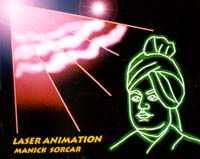 A poster from laser shows
A poster from laser shows |
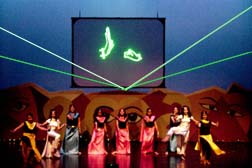 A scene from his show in the USA A scene from his show in the USA
|
In 2001, Sorcar lifted the bar for his laser technology when he showcased a live dancer in combination with a life size, on stage, laser-animated figure of her, entitled “Dancing with My Soul” for the first time in the USA. Since then this unique show along with many other items have created sensations around the world. The life size laser figure interacts with the dancer creating a truly multi-media production. "Like da Vinci," wrote The News Record of Cincinnati, Ohio, USA, "Sorcar is nothing short of a renaissance man. By combining laser beams, animation, computer graphics, magic and traditional Indian dances, Sorcar manages to create an awe-inspiring Indian fantasy world." |
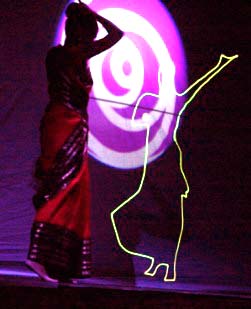
"Dancing with My Soul"
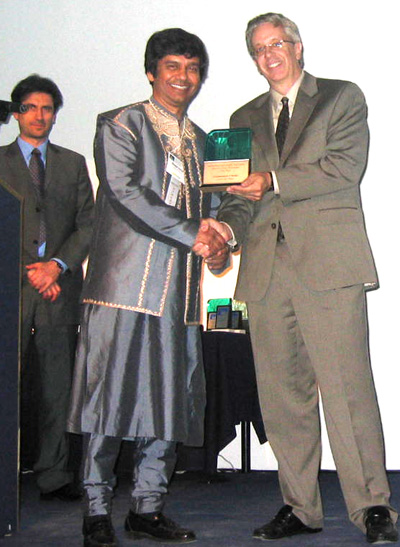
Manick Sorcar receives the 'ILDA Artistic Award' at Rimini, Italy for 'Best use of lasers in a live stage performance' category, for his production "Enlightenment of Buddha"
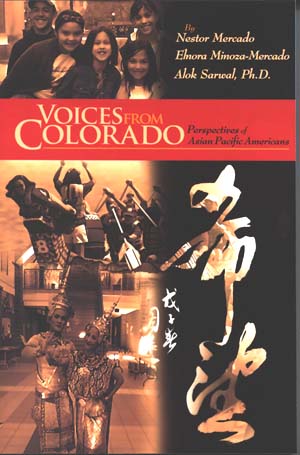
"Voices of Colorado: Perspectives
of Asian Americans"

"World of ManicK Sorcar"
by Roma Sur.

"East Meets West" by Wendy Luna
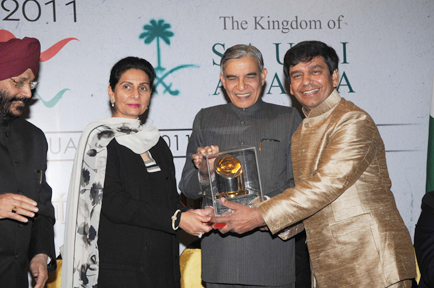
Receiving the Bharat Samman Award.
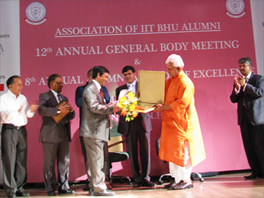
Receiving the IIT-BHU Lifetime Achievement Award
|
A string of
very creative laser shows, performed in a wide variety of prestigious
venues followed after this: "Feel Like a Kid Again"
at the Pepsi Center indoor stadium (opening show for
the football match between Colorado Crush and Grand
Rapids Rampage), "Celebrate Denver" at the Opening
Ceremony of the $350 million dollar Denver Convention Center,
"Back to the Future" for the Gold Rush XVIII at the
Two-River Convention Center of Grand Junction, USA, etc. Yet the
top award came in 2006, when his "Enlightenment of Buddha,"
an extravaganza of dance-drama-magic in combination with laser
graphics and overhead visual effects won the First Place and bagged
the 2005 ILDA Artistic Award for "best use of lasers
in a live stage performance" at the ceremony held at Rimini
in Italy on March 13.
On September 10, 2008, Sorcar received his second ILDA Artistic Award for the laser photography of his laser art "Reflection." He is the first Asian-American to receive the coveted award twice. ILDA (International Laser Display Association)
awards are considered as the industry's equivalent of Hollywood's
Oscars.
In 2011 his production "Our Republic's Birth" created a sensation when it was displayed at the 61st Republic Day of India celebration for the Consulate General of India at the historic Palace of Fine Arts, San Francisco. The show was attended by 400 international dignitaries including the Mayor of San Francisco, CA.
In 2012 Sorcar's production "Swamiji", an 1.5 hour laser show on Swami Vivekananda stormed the world. The premier of this unique show took place on October 10, 2012, at the Grand Theater of the Science City, Kolkata, the largest science center in the Indian subcontinent under National Council of Science Museums, Ministry of Culture, Government of India. The show was inaugurated by Ms. Kumari Selja, then the Honorable Minister for Culture, Housing & Urban Poverty Alleviation, Government of India. To date, it has been displayed in over 40 cities in India and the USA, receiving rave reviews from the press, media and Ramakrishna Missions, in addition to a national telecast in India.
Sorcar’s art and animation have been the subject of numerous articles, academic research papers, and books. For his simultaneous contribution to art and science, he was acclaimed as "the Renaissance Man of our time" in the book "Voices of Colorado: Perspectives of Asian Americans" by Nestor Mercado, Elnora Minoza-Mercado, and Alok Sarwal. In 2009, he was the subject of the book "World of Manick Sorcar: Where Art Becomes Magic" by Roma Sur, and in 2010, he was the subject of another book "East Meets West: The Animation of Manick Sorcar," by Wendy Luna. In the Foreword of the latter book , John W. Hickenlooper, the then Mayor of Denver - now the honorable Governor of Colorado, wrote "…This book is indeed a treasure in the multicultural wealth of our great nation. It is a tribute to Manick Sorcar, whose animation for the last two decades has both entertained and educated us about India, her culture, her people - all together, a true cultural bridge between East and West, which has made Denver, the United States and India proud."
In 2011, Jadavpur University, one of the top ranking universities of India, opened the Manick Sorcar Laser Animation Laboratory, where Sorcar donated laser lab equipment worth more than USD $120,000 and introduced India's first Laser for Art and Animation course as a special application of lighting for degrees in illumination engineering. He serves there as a visiting professor.
On January 10, 2011, Sorcar was bestowed with the "Bharat Samman (Honor of India): Achievers Award 2010", at the XXI Annual Meet NRI Divas 2011 of the NRI Institute, New Delhi. He received the prestigious award from the hands of Sri Pawan Kumar Bansal, the Honorable Union Minister of Parliamentary Affairs, in the presence of Maharani Preneet Kaur, the Honorable Union Minister of State for External Affairs, Govt. of India.
On November 6, 2013, Sorcar was honored with the Special Achievement Award for Cultural Enlightenment, for "exceptional merit in using laser display to celebrate India’s heritage, and to prepare the next generation by introducing a course on laser art and animation and establishing the Manick Sorcar Laser Animation Laboratory at Jadavpur University". It was given by the International Laser Display Association, at their 25th Annual Conference at Aalen, Germany. The news was carried internationally by newspapers including the Times of India.
His shows have been a fund raiser for several non-profit humanitarian organizations serving the victims of earthquakes, abused children, 9/11 and Tsunami tragedy.
............................
........................................
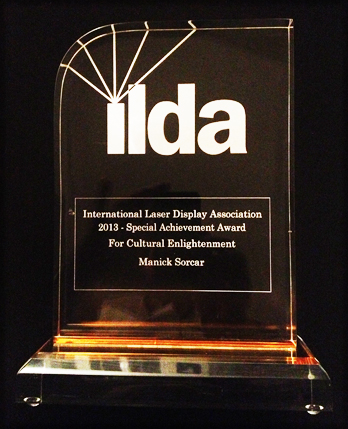
"Special Achievement Award For Cultural Enlightenment" ,
received from the ILDA, at Aalen, Germany
|
Sorcar retired from engineering business in December 2012 to devote all his time in his art of various form. Years ago, he decided not to do stage magic as he was more allured to art and lighting. But magic is in his blood, and creating miracle is his birthright. He keeps on hypnotizing the world with his own brand of magic with materials such as fine arts, cartoons, animations, laser arts, and world-touring stage extravaganza of live action mixed with laser animation, which has created a niche of his own.
On May 24, 2014, Sorcar was bestowed with the IIT-BHU Alumni Lifetime Achievement Award 2013-14 for his "outstanding contributions in the field of Cultural and Enlightenment through Science and Arts". He received the award in New Delhi, India from the hands of Manoj Sinha, the Honorable Minister of Railways, Govt. of India.
Manick Sorcar received 2021 ILDA Artistic Award in 'Laser Photography' category for his entry "Bouquet of Flowers", by winning the Second Place in international competition. The announcement was made by the ILDA (International Laser Display Association) on November 7, 2021, at their 'Cloud Conference' via Zoom. Originally, the ILDA 2021 Annual Conference was supposed to be held at Atlanta Beach, North Carolina, on October 5, 2021, which later was postponed to the 'Cloud Conference' via Zoom, due to Delta variant of COVID restrictions. The award was given to ‘LaserLight Magic’, Manick’s company for laser shows. Manick accepted the award and thanked via zoom.
Latest news: The winning streak goes on. Manick Sorcar received 2022 ILDA Artistic Award in 'Laser Photography' category for his entry "Butterfly in Flower Forest", by winning the Third Place in international competition. The announcement was made by the ILDA (International Laser Display Association) on November 5, 2022, at their ILDA Conference London 2022. The award was given to ‘LaserLight Magic’, Manick’s company for laser shows.
|
|

